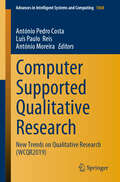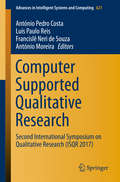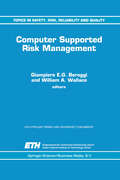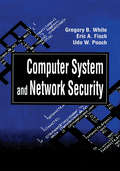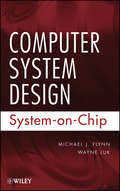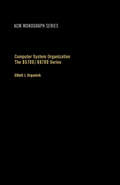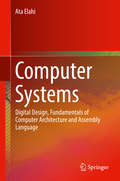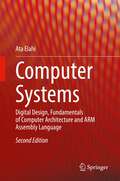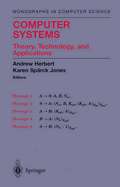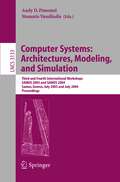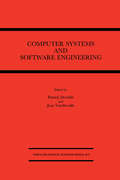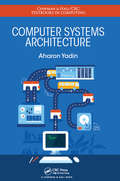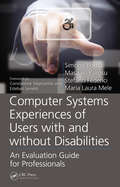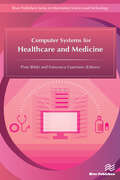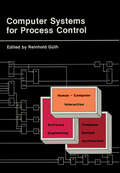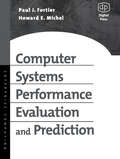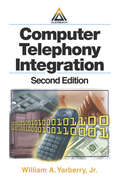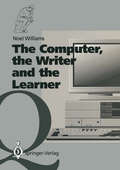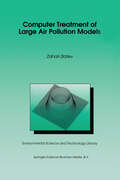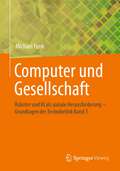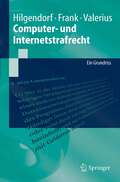- Table View
- List View
Computer Supported Qualitative Research: New Trends on Qualitative Research (WCQR2019) (Advances in Intelligent Systems and Computing #1068)
by António Pedro Costa Luís Paulo Reis António MoreiraThe World Conference on Qualitative Research (WCQR) is an annual event that aims to bring together researchers, academics and professionals, promoting the sharing and discussion of knowledge, new perspectives, experiences and innovations on the field of Qualitative Research. This book includes a selection of the articles accepted for presentation and discussion at WCQR2019, held in Porto, Portugal, October 16-18, 2019. WCQR2019 featured four main application fields (Education, Health, Social Sciences, and Engineering/Technology) and seven main subjects: Rationale and Paradigms of Qualitative Research; Systematization of Approaches with Qualitative Studies; Qualitative and Mixed Methods Research; Data Analysis Types; Innovative Processes of Qualitative Data Analysis; Qualitative Research in Web Context; Qualitative Analysis with Software Support. The book is a valuable resource for everyone interested in Qualitative Research with emphasis on Computer Assisted Qualitative Data Analysis.
Computer Supported Qualitative Research: Second International Symposium on Qualitative Research (ISQR 2017) (Advances in Intelligent Systems and Computing #621)
by António Pedro Costa Luís Paulo Reis Francislê Neri Souza António MoreiraThis book includes a selection of the articles accepted for presentation and discussion at the second International Symposium on Qualitative Research (ISQR2017), held in Salamanca, Spain, July 12-14, 2017. ISQR2017 is part of the Iberian-American Congress on Qualitative Research (CIAIQ), and featured four main application fields (Education, Health, Social Sciences, and Engineering and Technology) and seven main subjects: Rationale and Paradigms of Qualitative Research; Systematization of approaches with Qualitative Studies; Qualitative and Mixed Methods Research; Data Analysis Types; Innovative Processes of Qualitative Data Analysis; Qualitative Research in Web Contexts; Qualitative Analysis with the Support of Specific Software. This book is a valuable resource for academics, researchers, teachers and students who need information on the above topics, as well as on the use of Computer Assisted Qualitative Data AnalysiS (CAQDAS).
Computer Supported Risk Management (Topics in Safety, Risk, Reliability and Quality #4)
by Giampiero Beroggi W. A. WallaceAdvances in information technology provide opportunities for the development of computer systems that support risk managers in complex tasks. Leading experts report on the potentials and limitations concerning the use of computer systems in risk management. Their reports are based on many years of experience in their fields which include: risk analysis, systems engineering, geographic information systems, decision support systems, human--machine systems, and psychology. The book addresses four major issues in computer supported risk management: Conceptual aspects: the role, design, and use of computers in risk management Planning and policy analysis: transportation, equity analysis, emergency management, group decision making Operational decision making: nuclear power monitoring, emergency response, public safety warning, satellite tracking Commercial applications: GIS from IIASA, InterClair from IAEA, EPA software, cleanup decision support software survey. This book is meant for researchers, who will find the emerging issues in risk management that are motivated by the encounter of new tasks and novel technology; practitioners who will have descriptions and references of the state-of-the-art models and software; and students who will learn the basic concepts needed to develop advanced information and decision support systems in risk management.
Computer System and Network Security (Computer Science & Engineering)
by Gregory B. White Eric A. Fisch Udo W. PoochComputer System and Network Security provides the reader with a basic understanding of the issues involved in the security of computer systems and networks. Introductory in nature, this important new book covers all aspects related to the growing field of computer security. Such complete coverage in a single text has previously been unavailable, and college professors and students, as well as professionals responsible for system security, will find this unique book a valuable source of information, either as a textbook or as a general reference. Computer System and Network Security discusses existing and potential threats to computer systems and networks and outlines the basic actions that are generally taken to protect them. The first two chapters of the text introduce the reader to the field of computer security, covering fundamental issues and objectives. The next several chapters describe security models, authentication issues, access control, intrusion detection, and damage control. Later chapters address network and database security and systems/networks connected to wide-area networks and internetworks. Other topics include firewalls, cryptography, malicious software, and security standards. The book includes case studies with information about incidents involving computer security, illustrating the problems and potential damage that can be caused when security fails.This unique reference/textbook covers all aspects of computer and network security, filling an obvious gap in the existing literature.
Computer System and Network Security (Computer Science & Engineering #7)
by Gregory B. White Eric A. Fisch Udo W. PoochComputer System and Network Security provides the reader with a basic understanding of the issues involved in the security of computer systems and networks. Introductory in nature, this important new book covers all aspects related to the growing field of computer security. Such complete coverage in a single text has previously been unavailable, and college professors and students, as well as professionals responsible for system security, will find this unique book a valuable source of information, either as a textbook or as a general reference. Computer System and Network Security discusses existing and potential threats to computer systems and networks and outlines the basic actions that are generally taken to protect them. The first two chapters of the text introduce the reader to the field of computer security, covering fundamental issues and objectives. The next several chapters describe security models, authentication issues, access control, intrusion detection, and damage control. Later chapters address network and database security and systems/networks connected to wide-area networks and internetworks. Other topics include firewalls, cryptography, malicious software, and security standards. The book includes case studies with information about incidents involving computer security, illustrating the problems and potential damage that can be caused when security fails.This unique reference/textbook covers all aspects of computer and network security, filling an obvious gap in the existing literature.
Computer System Design: System-on-Chip
by Michael J. Flynn Wayne LukThe next generation of computer system designers will be less concerned about details of processors and memories, and more concerned about the elements of a system tailored to particular applications. These designers will have a fundamental knowledge of processors and other elements in the system, but the success of their design will depend on the skills in making system-level tradeoffs that optimize the cost, performance and other attributes to meet application requirements. This book provides a new treatment of computer system design, particularly for System-on-Chip (SOC), which addresses the issues mentioned above. It begins with a global introduction, from the high-level view to the lowest common denominator (the chip itself), then moves on to the three main building blocks of an SOC (processor, memory, and interconnect). Next is an overview of what makes SOC unique (its customization ability and the applications that drive it). The final chapter presents future challenges for system design and SOC possibilities.
Computer System Design: System-on-Chip
by Michael J. Flynn Wayne LukThe next generation of computer system designers will be less concerned about details of processors and memories, and more concerned about the elements of a system tailored to particular applications. These designers will have a fundamental knowledge of processors and other elements in the system, but the success of their design will depend on the skills in making system-level tradeoffs that optimize the cost, performance and other attributes to meet application requirements. This book provides a new treatment of computer system design, particularly for System-on-Chip (SOC), which addresses the issues mentioned above. It begins with a global introduction, from the high-level view to the lowest common denominator (the chip itself), then moves on to the three main building blocks of an SOC (processor, memory, and interconnect). Next is an overview of what makes SOC unique (its customization ability and the applications that drive it). The final chapter presents future challenges for system design and SOC possibilities.
Computer System Organization: The B5700/B6700 Series
by Elliott I. OrganickComputer System Organization: The B5700/B6700 Series focuses on the organization of the B5700/B6700 Series developed by Burroughs Corp. More specifically, it examines how computer systems can (or should) be organized to support, and hence make more efficient, the running of computer programs that evolve with characteristically similar information structures.Comprised of nine chapters, this book begins with a background on the development of the B5700/B6700 operating systems, paying particular attention to their hardware/software architecture. The discussion then turns to the block-structured processes involved in the B6700 job, which consists of a time-invariant algorithm and a time-varying data structure which is the record of execution of that algorithm. Subsequent chapters deal with the basic data structures for B6700 algorithms; task attributes and the creation and coordination of tasks; stack structure and stack ownership; and software interrupts. Storage control strategies as well as the pros and cons of B6700 are also considered, along with some hardware details of procedure entry and return and tasking. This monograph is intended for computer center directors, other computer professionals, and serious students in computer science who have an interest in the subject of computer organization.
Computer Systems: Digital Design, Fundamentals of Computer Architecture and Assembly Language
by Ata ElahiThis textbook covers digital design, fundamentals of computer architecture, and assembly language. The book starts by introducing basic number systems, character coding, basic knowledge in digital design, and components of a computer. The book goes on to discuss information representation in computing; Boolean algebra and logic gates; sequential logic; input/output; and CPU performance. The author also covers ARM architecture, ARM instructions and ARM assembly language which is used in a variety of devices such as cell phones, digital TV, automobiles, routers, and switches. The book contains a set of laboratory experiments related to digital design using Logisim software; in addition, each chapter features objectives, summaries, key terms, review questions and problems. The book is targeted to students majoring Computer Science, Information System and IT and follows the ACM/IEEE 2013 guidelines. • Comprehensive textbook covering digital design, computer architecture, and ARM architecture and assembly • Covers basic number system and coding, basic knowledge in digital design, and components of a computer • Features laboratory exercises in addition to objectives, summaries, key terms, review questions, and problems in each chapter
Computer Systems: Digital Design, Fundamentals of Computer Architecture and ARM Assembly Language
by Ata ElahiThis updated textbook covers digital design, fundamentals of computer architecture, and ARM assembly language. The book starts by introducing computer abstraction, basic number systems, character coding, basic knowledge in digital design, and components of a computer. The book goes on to discuss information representation in computing, Boolean algebra and logic gates, and sequential logic. The book also presents introduction to computer architecture, Cache mapping methods, and virtual memory. The author also covers ARM architecture, ARM instructions, ARM assembly language using Keil development tools, and bitwise control structure using C and ARM assembly language. The book includes a set of laboratory experiments related to digital design using Logisim software and ARM assembly language programming using Keil development tools. In addition, each chapter features objectives, summaries, key terms, review questions, and problems.
Computer Systems: Theory, Technology, and Applications (Monographs in Computer Science)
by Andrew James Herbert Karen I. B. Spaerck JonesAn invited collection of peer-reviewed papers surveying key areas of Roger Needham's distinguished research career at Cambridge University and Microsoft Research. From operating systems to distributed computing, many of the world's leading researchers provide insight into the latest concepts and theoretical insights--many of which are based upon Needham's pioneering research work. A critical collection of edited-survey research papers spanning the entire range of Roger Needham's distinguished scientific career, from operating systems to distributed computing and security. Many of the world's leading researchers survey their topics' latest developments and acknowledge the theoretical foundations of Needham's work. Introduction to book written by Rick Rashid, Director of Microsoft Research Worldwide.
Computer Systems: Third and Fourth International Workshop, SAMOS 2003 and SAMOS 2004, Samos, Greece, July 21-23, 2003 and July 19-21, 2004, Proceedings (Lecture Notes in Computer Science #3133)
by Andy Pimentel Stamatis VassiliadisComputer Systems and Software Engineering: State-of-the-art
by Patrick DeWilde Joos P. L. VandewalleComputer Systems and Software Engineering is a compilation of sixteen state-of-the-art lectures and keynote speeches given at the COMPEURO '92 conference. The contributions are from leading researchers, each of whom gives a new insight into subjects ranging from hardware design through parallelism to computer applications. The pragmatic flavour of the contributions makes the book a valuable asset for both researchers and designers alike. The book covers the following subjects: Hardware Design: memory technology, logic design, algorithms and architecture; Parallel Processing: programming, cellular neural networks and load balancing; Software Engineering: machine learning, logic programming and program correctness; Visualization: the graphical computer interface.
Computer Systems Architecture (Chapman & Hall/CRC Textbooks in Computing)
by Aharon YadinComputer Systems Architecture provides IT professionals and students with the necessary understanding of computer hardware. It addresses the ongoing issues related to computer hardware and discusses the solutions supplied by the industry. The book describes trends in computing solutions that led to the current available infrastructures, tracing the initial need for computers to recent concepts such as the Internet of Things. It covers computers’ data representation, explains how computer architecture and its underlying meaning changed over the years, and examines the implementations and performance enhancements of the central processing unit (CPU). It then discusses the organization, hierarchy, and performance considerations of computer memory as applied by the operating system and illustrates how cache memory significantly improves performance. The author proceeds to explore the bus system, algorithms for ensuring data integrity, input and output (I/O) components, methods for performing I/O, various aspects relevant to software engineering, and nonvolatile storage devices, such as hard drives and technologies for enhancing performance and reliability. He also describes virtualization and cloud computing and the emergence of software-based systems’ architectures. Accessible to software engineers and developers as well as students in IT disciplines, this book enhances readers’ understanding of the hardware infrastructure used in software engineering projects. It enables readers to better optimize system usage by focusing on the principles used in hardware systems design and the methods for enhancing performance.
Computer Systems Architecture (Chapman & Hall/CRC Textbooks in Computing)
by Aharon YadinComputer Systems Architecture provides IT professionals and students with the necessary understanding of computer hardware. It addresses the ongoing issues related to computer hardware and discusses the solutions supplied by the industry. The book describes trends in computing solutions that led to the current available infrastructures, tracing the initial need for computers to recent concepts such as the Internet of Things. It covers computers’ data representation, explains how computer architecture and its underlying meaning changed over the years, and examines the implementations and performance enhancements of the central processing unit (CPU). It then discusses the organization, hierarchy, and performance considerations of computer memory as applied by the operating system and illustrates how cache memory significantly improves performance. The author proceeds to explore the bus system, algorithms for ensuring data integrity, input and output (I/O) components, methods for performing I/O, various aspects relevant to software engineering, and nonvolatile storage devices, such as hard drives and technologies for enhancing performance and reliability. He also describes virtualization and cloud computing and the emergence of software-based systems’ architectures. Accessible to software engineers and developers as well as students in IT disciplines, this book enhances readers’ understanding of the hardware infrastructure used in software engineering projects. It enables readers to better optimize system usage by focusing on the principles used in hardware systems design and the methods for enhancing performance.
Computer Systems Experiences of Users with and Without Disabilities: An Evaluation Guide for Professionals
by Simone Borsci Masaaki Kurosu Stefano Federici Maria Laura MeleThis book provides the necessary tools for the evaluation of the interaction between the user who is disabled and the computer system that was designed to assist that person. The book creates an evaluation process that is able to assess the user's satisfaction with a developed system. Presenting a new theoretical perspective in the human computer i
Computer Systems for Healthcare and Medicine
by Piotr Bilski Francesca GuerrieroThe development of modern civilization leads to us having to solve new problems which did not exist before. The contemporary world faces a great challenge of aging societies, where the increasing number of citizens requires constant medical attention. To ensure safety and wellbeing of elderly people, patients in hospitals and disabled persons, advanced technologies can be implemented. These include both sophisticated data acquisition systems and data processing algorithms, aiming at the constant and discreet monitoring of persons whilst raising alarm if immediate attention is required.Computer Systems for Healthcare and Medicine presents a novel look at the introduced problems, including proposed solutions in the form of automated data acquisition and processing systems, which were tested in various environments. Characteristic features include a wide range of sensors used to monitor the situation of the person, and accurate decision making algorithms, often based on the computational intelligence domain. Technical topics discussed in the book include application for the healthcare of the following:Infrared sensorsMEMSUltra wideband radarsDeep learningDecision treesArtificial neural networksGabor filtersDecision support systems
Computer Systems for Healthcare and Medicine
The development of modern civilization leads to us having to solve new problems which did not exist before. The contemporary world faces a great challenge of aging societies, where the increasing number of citizens requires constant medical attention. To ensure safety and wellbeing of elderly people, patients in hospitals and disabled persons, advanced technologies can be implemented. These include both sophisticated data acquisition systems and data processing algorithms, aiming at the constant and discreet monitoring of persons whilst raising alarm if immediate attention is required.Computer Systems for Healthcare and Medicine presents a novel look at the introduced problems, including proposed solutions in the form of automated data acquisition and processing systems, which were tested in various environments. Characteristic features include a wide range of sensors used to monitor the situation of the person, and accurate decision making algorithms, often based on the computational intelligence domain. Technical topics discussed in the book include application for the healthcare of the following:Infrared sensorsMEMSUltra wideband radarsDeep learningDecision treesArtificial neural networksGabor filtersDecision support systems
Computer Systems for Process Control
by Reinhold GüthThe Brown Boveri Symposia are by now part of a firm!ly established tradition. This is the ninth event in a series which was initiated shortly after Corporate Research was created as a separate entity within our Company; the Symposia are held every other year. The themes to date have been: 1969 Flow Research on Blading 1971 Real-Time Control of Electric Power Systems 1973 High-Temperature Materials in Gas Turbines 1975 Nonemissive Electrooptic Displays 1977 Current Interruption in High-Voltage Networks 1979 Surges in High-Voltage Networks 1981 Semiconductor Devices for Power Conditionling 1983 Corrosion in Power Generating Equipment 1985 Computer Systems for Process Control Why have we chosen these topics? At the outset we established certain selection criteria; we felt that a subject for a symposium should fulfill the following three requirements: It should characterize a part of a thoroughly scientific discipline; in other words it should describe an area of scholarly study and research. r - It should be of current interest in the sense that important results have recently been obtained and considerable research effort is presently underway in the international scientific community. - It should bear some relation to the scientific and technological activity of our Company. Let us look at the requirement "current interest": Some of the topics on the list above have been the subject of research for several decades, some even from the - v vi FOREWORD ginning of the century.
Computer Systems Performance Evaluation and Prediction
by Paul Fortier Howard MichelComputer Systems Performance Evaluation and Prediction bridges the gap from academic to professional analysis of computer performance.This book makes analytic, simulation and instrumentation based modeling and performance evaluation of computer systems components understandable to a wide audience of computer systems designers, developers, administrators, managers and users. The book assumes familiarity with computer systems architecture, computer systems software, computer networks and mathematics including calculus and linear algebra.· Fills the void between engineering practice and the academic domain's treatment of computer systems performance evaluation and assessment· Provides a single source where the professional or student can learn how to perform computer systems engineering tradeoff analysis· Allows managers to realize cost effective yet optimal computer systems tuned to a specific application
Computer Telephony Integration
by William A. Yarberry Jr.Since the publication of the first edition, the CTI world has changed significantly. Where it was once focused on the integration of voice systems with computers, the focus is now on IP-based voice, or converged networks and services. Today, the telcos are upgrading their systems from circuit-switched to IP-based packet-switched networks. Companies
The Computer, the Writer and the Learner
by Noel WilliamsComputers are gradually infiltrating all stages of the writing process. Increasingly, teachers, writers, students, software developers, technical authors, and computer scientists need to learn more about the effective use of computers for writing. This book discusses how computers can help support writing. It explores the issues associated with using computers to train and help writers, concentrating on computational and user aspects and reviewing practical, economic and institutional issues. Noel Williams balances theoretical and practical concerns, to meet the needs of researchers and practising trainers of writing. There is also a brief evaluation available software products, together with advice about the major considerations and pitfalls of working on custom-made software. The book is based on five years of research by the Communication and Information Research Group (CIRG) at Sheffield City Polytechnic into the value of computer-based approaches to training and helping writers. The work was funded and supported by the Training Agency, IBM, AT&T, Rolls Royce, NAB and GEC. The Computer, the Writer and the Learner is for people who are using, or are thinking of using, computers to teach or support writing, and for designers of computer-based writing systems. Many such people are unaware of the nature and use of existing systems, and of the possibilities they offer. Developers often lack detailed knowledge of other projects and of the range of users' needs. Although the bias of the book is towards the teacher, trainer and student, most of the content deals with issues that developers will want to know about.
Computer Treatment of Large Air Pollution Models (Environmental Science and Technology Library #2)
by Zahari Zlatev"Models are often the only way of interpreting measurements to in vestigate long-range transport, and this is the reason for the emphasis on them in many research programs". B. E. A. Fisher: "A review of the processes and models of long-range transport of air pollutants", Atmospheric Environment, 17(1983), p. 1865. Mathematical models are (potentially, at least) powerful means in the efforts to study transboundary transport of air pollutants, source-receptor relationships and efficient ways of reducing the air pollution to acceptable levels. A mathematical model is a complicated matter, the development of which is based on the use of (i) various mechanisms describing mathematically the physical and chemical properties of the studied phenomena, (ii) different mathematical tools (first and foremost, partial differenti al equations), (iii) various numerical methods, (iv) computers (especially, high-speed computers), (v) statistical approaches, (vi) fast and efficient visualization and animation techniques, (vii) fast methods for manipulation with huge sets of data (input data, intermediate data and output data).
Computer und Gesellschaft: Roboter und KI als soziale Herausforderung – Grundlagen der Technikethik Band 3
by Michael FunkWelche Wirkungen haben Robotik und Künstliche Intelligenz (KI) auf die Gesellschaft? Wie verändern Algorithmen und Machine Learning unser soziales Umfeld? Vor welchen ethischen Herausforderungen stehen wir? Vorliegendes Buch bietet zu diesen und weiteren Fragen systematische Analysen. Allgemeine und spezielle Roboterkonzepte von Androiden über Social Robots bis hin zu kollaborativen Industrierobotern werden vorgestellt. Hinzu treten Drohnen im militärischen und zivilen Einsatz sowie diverse Formen der Mensch-Maschine-, Tier-Maschine- und Pflanze-Maschine-Interaktion. Verschiedene Begriffe und Paradigmen der KI werden auch abseits der Informatik herausgearbeitet, reale und spekulative Entwicklungen eingeordnet. Vor diesem Hintergrund geraten ethisch-gesellschaftliche Brennpunkte in den Blick. Beispiele, Aufgaben, vertiefende Infos zu Hintergründen und Übersichten laden zum kritischen Weiterdenken ein. Es bildet den dritten, in sich abgerundeten Teil der Buchreihe Grundlagen der Technikethik.Haben wir die Zukunft, die wir brauchen, und brauchen wir die Zukunft, die wir haben?
Computer- und Internetstrafrecht: Ein Grundriss (Springer-Lehrbuch)
by Eric Hilgendorf Thomas Frank Brian ValeriusDie moderne Informations- und Kommunikationstechnologie stellt das Recht vor neue Herausforderungen. Das Lehrbuch vermittelt einen umfassenden und zugleich detaillierten Überblick über das Computer- und Internetstrafrecht, angefangen vom klassischen Computerbetrug und Hacking von Daten bis hin zu den jüngsten kriminellen Erscheinungsformen wie Domain-Hijacking und Phishing. Darüber hinaus widmet es sich auch künftigen Entwicklungen, vor allem der zunehmenden Internationalisierung des Rechts auf diesem Gebiet.
